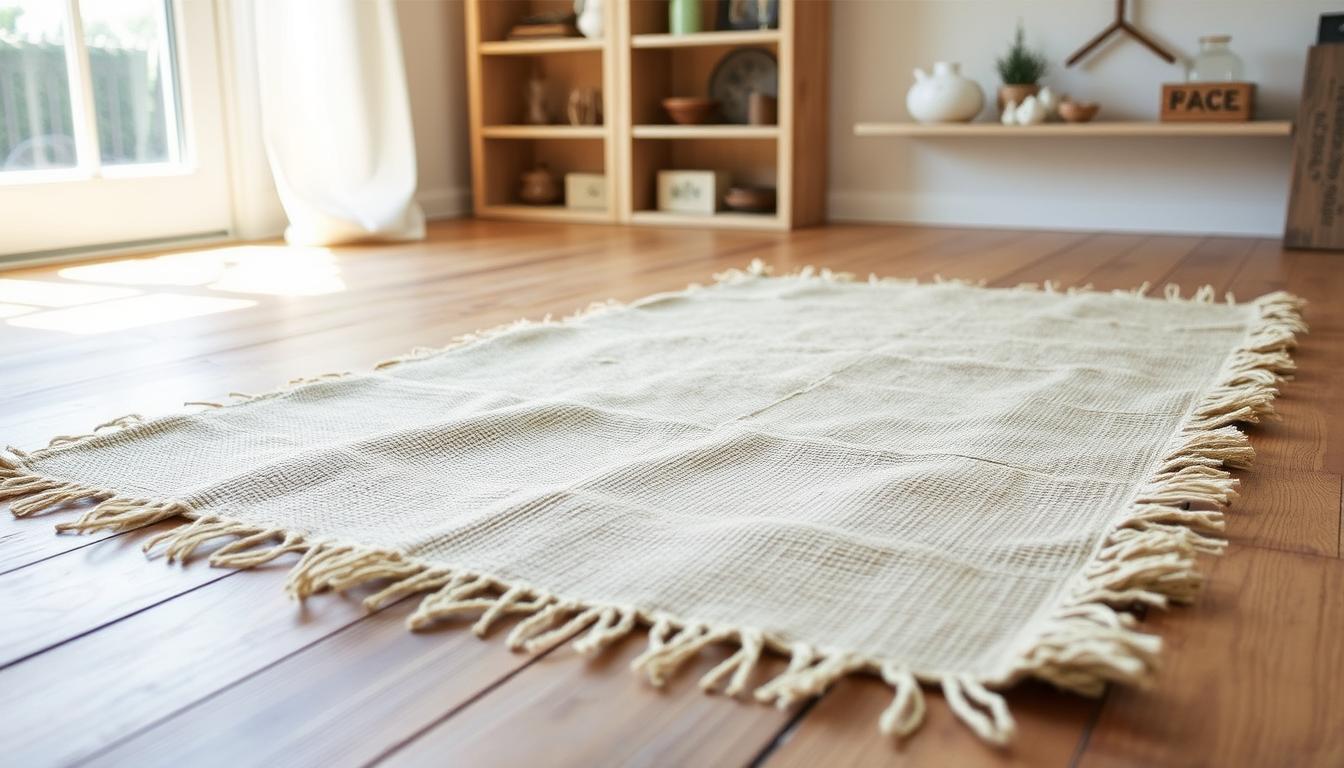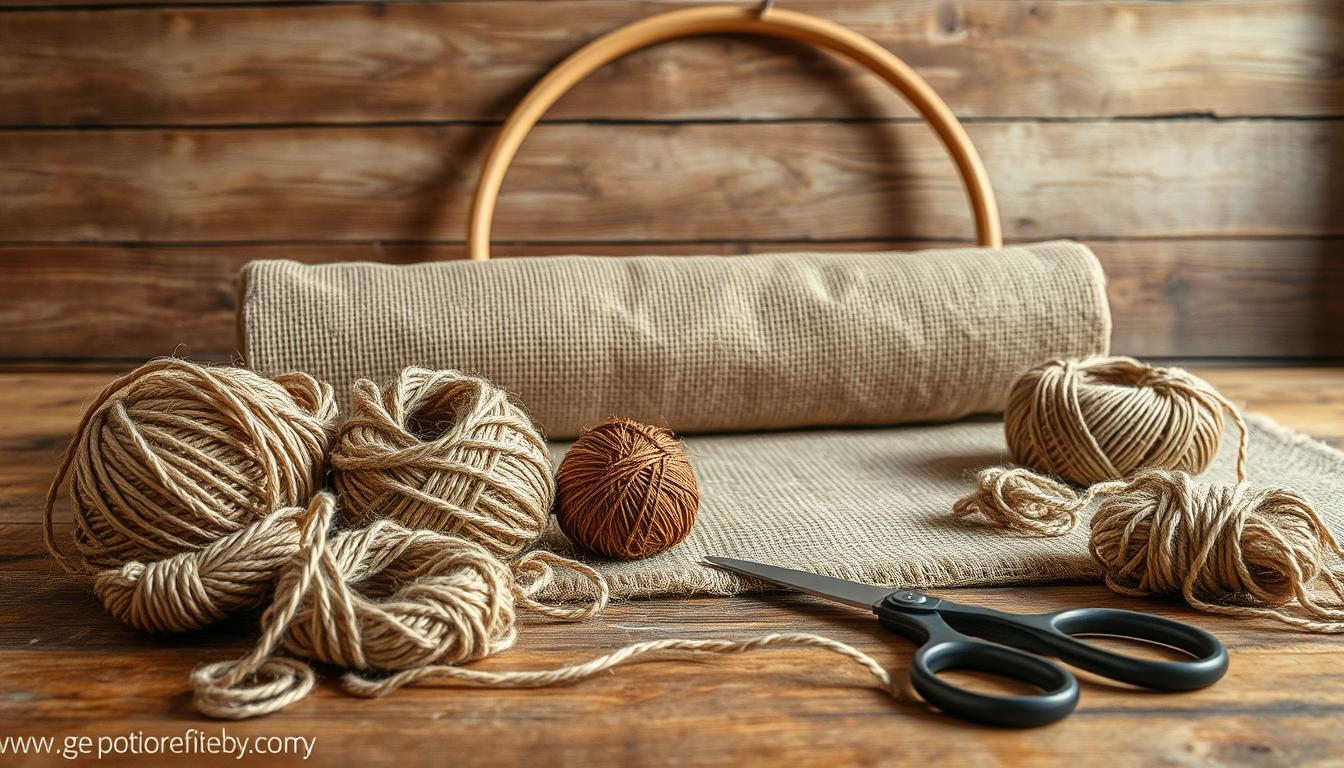
5 Rustic DIY Steps for a Burlap Rug
What if you could craft a designer-quality floor covering for less than the price of a takeout dinner? While mass-produced options dominate store shelves, there’s a growing movement toward handmade home decor that blends affordability with artisanal charm. This guide revives an ancient artistic tradition—block printing—and adapts it for modern creators seeking a personalized touch.

Originally used for intricate textile designs, block printing involved carving patterns into wood and stamping fabrics. Today, you’ll use accessible tools like stencils and acrylic paint to achieve similar timeless aesthetics on durable natural fibers. The result? A custom piece that withstands heavy foot traffic while adding warmth to kitchens, entryways, or patios.
No prior crafting expertise? Perfect. This method simplifies traditional techniques into five manageable stages. You’ll control every detail—from dimensions to color schemes—ensuring your creation aligns perfectly with farmhouse, bohemian, or minimalist interiors. Best of all, materials cost about $30 compared to $200+ for store-bought alternatives.
Key Takeaways
- Create high-impact decor for 85% less than retail prices
- Adapt ancient block printing methods with modern stencils
- Customize size and patterns to match your interior style
- Use durable materials suited for busy household areas
- Complete the project with basic tools and zero specialized skills
Materials, Tools, and Inspiration for Your diy Burlap rug
Gathering the right components transforms ordinary supplies into a lasting statement piece. Start with natural fiber floor coverings like jute or sisal—durable bases that withstand daily wear. These materials blend seamlessly with modern farmhouse or coastal aesthetics while offering slip-resistant surfaces.

Essential Supplies and Natural Fibers
Source coffee sacks through local listings for under $1 each—11 bags create a 9.5x11 ft surface. Pair them with acrylic craft paint (small bottles cover 3 sq ft) and stencil brushes. For rope designs, natural fiber options cost $0.58 per foot at hardware stores.
Sharp blades ensure clean cuts through coarse fabrics. Use painter’s tape to secure patterns during application. Mix leftover wall paint with fabric medium for custom hues that stay vibrant through washes.
Smart Sourcing Strategies
Check craft store clearance sections for discounted stencil materials. Bulk rope purchases lower per-foot costs for larger projects. Some suppliers offer affiliate programs—ideal when creating multiple pieces for gift-giving or home renovations.
Protect work surfaces with silicone mats during adhesive steps. Store unused paint in airtight containers for touch-ups later. With proper planning, your final creation rivals high-end store displays at 15% of retail pricing.
The Step-by-Step Process to Create Your Rug
Transform raw materials into a functional masterpiece through precise execution. Follow these stages carefully to maintain structural integrity while achieving professional results.
Preparing and Cutting Your Base Material
Measure your workspace and add 4" extra on all sides for hemming. Use rotary cutters instead of scissors—their sharp blades slice through loose fibers cleanly. Work outdoors or lay down drop cloths to contain dust from natural textiles.
Stencil Application Strategies
Position your chosen template and secure it with painter’s tape. Load stencil brushes with thick acrylic paint, tapping off excess before contact. Press straight downward—no sideways motions—to prevent smudging. Let each layer dry 20 minutes before adding secondary patterns.
Thin paints? Pour small amounts into shallow containers. Air exposure thickens them naturally within 30 minutes. Test consistency by dabbing on scrap fabric first.
Adhesive Management and Curing
Apply construction-grade glue in 12" sections. Press rope coils firmly into adhesive rows, aligning ends precisely. Place encyclopedia volumes or concrete blocks over completed areas for 3+ hours. This weight prevents shifting while bonding fibers permanently.
Remove residual coffee odors by machine-washing twice with oxygen bleach. Air-dry flat to preserve shape. For rope edges, tease apart strands with a seam ripper to create artful fringe.
Creative Design Ideas and Customization Tips
Personalizing your natural fiber floor covering transforms functional decor into artistic expression. Whether crafting a cozy bedroom accent or durable kitchen runner, these strategies help match your room's personality while maximizing practicality.

Choosing Your Pattern and Color Scheme
Geometric mandala designs create visual balance in open-concept spaces. For entryways, try door-sized mats with repeating diamond grids. Earthy terracotta and sage green paints complement farmhouse kitchens, while cobalt blue makes modern living rooms pop.
| Room | Ideal Size | Pattern Style | Color Palette |
|---|---|---|---|
| Entryway | 24"x36" | Bold geometrics | High-contrast neutrals |
| Hallway | Runner (2'x8') | Continuous lines | Monochromatic tones |
| Living Room | 9.5'x11' | Cultural motifs | Rich jewel tones |
| Kids' Room | 5' round | Whimsical shapes | Primary colors |
Incorporating Unique Textures and Details
Mix thick and thin ropes along edges for dimensional borders. Try ombre effects by blending three paint shades on stencils. Metallic gold accents elevate basic patterns into gallery-worthy pieces.
Painter's tape creates crisp lines between color blocks. For patios, use outdoor-rated sealant over designs. Explore our Pinterest board for more tufted rug that work with jute materials.
Conclusion
Crafting your own floor decor unlocks possibilities mass-produced items can’t match. You’ve mastered a five-stage method that blends traditional artistry with modern efficiency, producing pieces at 85% less than store prices. Every detail—from paint colors to geometric patterns—adapts to your space’s unique character.
Natural fibers like jute ensure lasting durability while maintaining slip-resistant qualities. Use gripper tape under edges on hardwood or tile floors for added safety. For inspiration on advanced textures, explore our guide to handcrafted elegance techniques that elevate basic designs.
Your new skills extend beyond floor coverings. Create matching table runners, wall art, or entryway mats using the same principles. Remember to rotate placements to minimize wear in active areas.
This project proves home accents needn’t sacrifice personality for practicality. With under $30 in materials and an afternoon’s work, you’ve gained lifelong creative tools. What unique piece will you design next?
FAQ
How durable are natural fiber rugs like jute or burlap?
Natural fibers like jute and sisal offer moderate durability, ideal for low-traffic areas. They’re resistant to wear but may fray over time. For high-traffic zones, consider reinforcing edges with fabric glue or binding tape.
Can I use stencils to create patterns on my rug?
Yes! Stencils work well for adding geometric or floral designs. Use fabric paint and secure the stencil with painter’s tape. Brands like DecoArt or FolkArt offer washable paints that adhere to natural fibers.
Where can I find affordable materials for this project?
A> Check craft stores like Michaels or Joann Fabrics for burlap rolls and fabric paints. Online retailers such as Amazon also carry bulk jute rolls. Look for coupons or seasonal sales to save costs.
How long does adhesive take to dry on natural fibers?
A> Drying times vary based on adhesive type. Water-based options like Mod Podge dry in 1–2 hours. Ensure proper ventilation and avoid placing heavy objects on the rug until fully cured.
What’s the best way to clean a handmade fiber rug?
A> Spot-clean with mild soap and cold water. Avoid soaking burlap or jute, as moisture can weaken fibers. For deeper stains, use a handheld steam cleaner on low settings.
Can I mix textures like rope or yarn into the design?
A> Absolutely! Adding braided rope borders or woven yarn accents creates visual interest. Secure materials with heavy-duty thread or fabric glue for a cohesive look.









